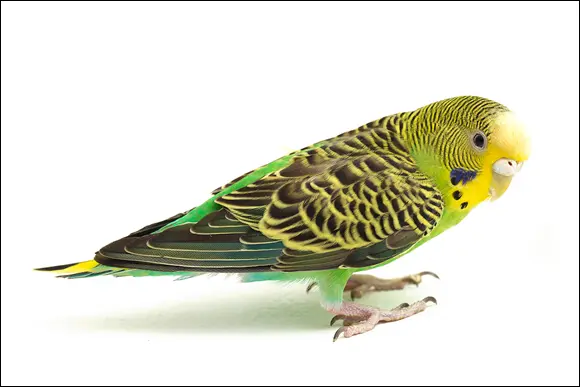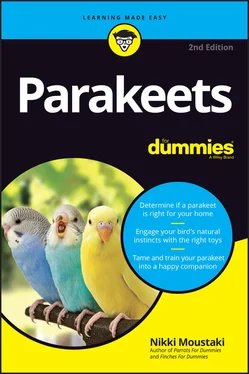 Discovering the life of a wild parakeet
Discovering the life of a wild parakeet
The word parakeet is a generic term for any smallish, slender bird in the parrot family that has a long, tapered tail. But when most people think “parakeet,” they think of the small, brightly colored bird common to most pet shops and to almost everyone’s childhood.
Parakeets are about 7 inches in length (with the English budgie at around 9 inches), and most of that length is taken up by the tail. This species, Melopsittacus undulatus , also called the budgerigar ( budgie is its nickname), is found in large flocks in the grasslands of the Australian outback. The English budgie has the same Latin species name, even though it is much larger.
WHERE PARAKEETS COME FROM
Parakeets arrived in Europe around 1838, brought from Australia by British naturalist John Gould and his brother-in-law, Charles Coxen, who raised the first clutch (batch of babies). Europeans found that these birds were easy to breed, and wealthy people fell in love with them. They soon became popular in Germany, Belgium, France, and Holland.
A yellow mutation occurred in Belgium around 1875, leading to other color mutations, including olive, dark green, gray-green. Companion parakeets were simply green, as they are in the wild, until around 1881 when a Dutch bird keeper found a blue chick hatched in the nest boxes. This blue bird was responsible for other mutations: cobalt, mauve, slate, gray, and violet.
The parakeet arrived in America around the late 1920s, but didn’t become popular as a companion until the 1950s. Today, there are hundreds of color mutations and variations. Even so, the most common colors are the most popular: green, blue, yellow, and white.
The American Parakeet versus the English Budgie
Though the American parakeet and the English budgie both got their start in Australia, the American parakeet is more similar to its wild cousin than the English budgie. The English budgie is what hobbyists call an exhibition bird or a show budgie, because it is often shown in large budgie shows (kind of like dog shows, but for birds). It’s nearly twice the size of the American parakeet, and it claims its English name because the British, who received the exhibition size budgie from Western Europe, sent the exhibition budgie to America.
The English budgie is basically domesticated, which means that it has been changed from its wild form using selective breeding practices. This kind of selective breeding (choosing to breed only the animals that have desired traits so that the young will also have and pass on these traits to future generations) is what humans have done with dogs for thousands of years. (Notice how different dog breeds look so dissimilar from one another — it’s hard to imagine that they all originated from a couple of species of wild dog.) Though no parrot is truly domesticated, the English budgie is the closest.
Though technically called the budgie, the terms parakeet and budgie are interchangeable (see Figure 1-1). Some people call the larger version of the parakeet the budgie and the smaller version the parakeet — but it really doesn’t matter which term you use. For the purposes of this book, I refer to these little birds as parakeets. The basic differences are as follows:
Size difference: The American parakeet is smaller, thinner, and more streamlined than its British counterpart. The English show budgie is stately looking, with a full, prominent chest and forehead. Its eyes are barely evident and its beak is tucked into the feathers of its face. It is 8½ to 9½ inches long, whereas the American is about 7 inches long. FIGURE 1-1:The English budgie (left, male) and American parakeets (right, female, male).
Temperament: The American parakeet is feistier than the English budgie and may be more active than its mellower cousin. Both birds are good companions. Whichever type you choose, you can tame the bird into a wonderful pal, or keep a pair to watch and add some liveliness to your home.
Lifespan: Lifespan is one of the primary differences between the parakeet and the budgie. The big English budgie lives about 7 to 8 years, and the American parakeet can live 14 years or more with the proper care.
The Anatomy of a Parakeet
Knowing your bird’s anatomy will help you describe a problem to an avian veterinarian if you ever have to do so. You can also speak like an expert with other hobbyists. Here are the primary parts of your parakeet (see Figure 1-2):
Crown: The crown is the top of the head.
Nares (nostrils): The nares are at the top of the beak.
Cere: The cere is the fleshy area above the beak that contains the nostrils. It becomes blue in mature male parakeets, and brown in breeding condition females. When parakeets are young, it’s white to light pink. The cere is a purplish-pink in males and a whitish-blue in females (when females are not in breeding condition).
Beak: The upper and lower mandibles (jaws) make up the parakeet’s beak. The parakeet is classified as a hookbill, meaning that the beak is shaped like a hook and is perfect for cracking seeds and breaking twigs.
Ear: Your parakeet has small flat holes for ears, and they’re covered by thin feathers that protect the ear. This is why you can’t see them unless your bird is wet.
Eyes: The parakeet’s eyes are on either side of its head so that its field of vision is about 300 degrees. By contrast, a human’s field of vision is about 120 degrees. This wider view of the world is because the parakeet is a prey animal and needs to be constantly on alert for predators. Parakeets, like many birds, have a third eyelid called a nictitating membrane, which is a thin, semitransparent lid that washes the eye like a squeegee and closes for protection.
Throat: The throat is just beneath the beak and extends to the breast.
Nape: The nape is the back of the neck.
Shoulder: The shoulder is at the top of the wing nearest the parakeet’s back.
Breast: The breast is just below the throat.
Foot: Everything that most of us think of as a bird’s leg is actually a bird’s foot. That’s why the “knee” appears to bend the wrong way — it’s actually the bird’s heel. The parakeet’s foot is zygodactyl, meaning it has two toes in front and two in back, perfect for grasping and climbing.
Vent: The vent is where your bird eliminates. In a human, this would be a combined anus and urethra. Birds’ urine is not separate from their droppings; urine is combined with the fecal portion of the dropping as a small wet outer ring.
Primary feathers: Parakeets have ten long primary wing feathers that aid in flight.
Secondary feathers: The secondary feathers on the wing occur after the primaries, closer to the body.
Rump: The rump is beneath the primary flight feathers on the parakeet’s lower back.
Mantle: The mantle is the back area between the shoulders of the parakeet.
Crop: The crop is a sac-like organ that’s kind of like a “first stomach.” It’s where the food goes immediately after being swallowed and is located at the top of the breast.
Syrinx: The syrinx is equivalent to vocal chords in humans. It allows parakeets to talk and vocalize when air is pushed through it.

FIGURE 1-2:All the parts of a healthy parakeet.
Читать дальше

 Discovering the life of a wild parakeet
Discovering the life of a wild parakeet











